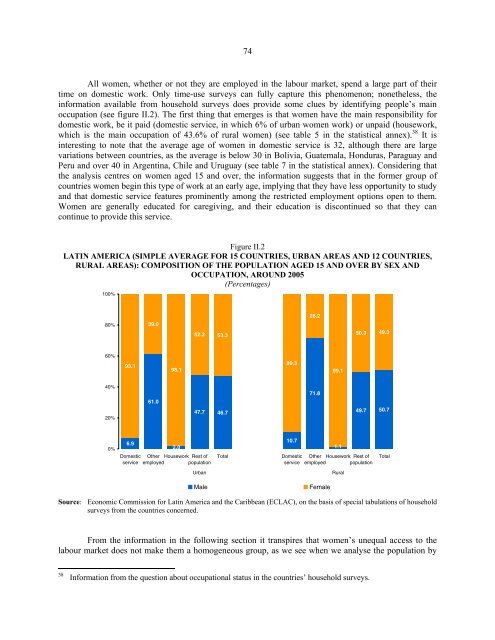Women in Latin America and the Caribbean - Cepal
Women in Latin America and the Caribbean - Cepal
Women in Latin America and the Caribbean - Cepal
Create successful ePaper yourself
Turn your PDF publications into a flip-book with our unique Google optimized e-Paper software.
74<br />
All women, whe<strong>the</strong>r or not <strong>the</strong>y are employed <strong>in</strong> <strong>the</strong> labour market, spend a large part of <strong>the</strong>ir<br />
time on domestic work. Only time-use surveys can fully capture this phenomenon; none<strong>the</strong>less, <strong>the</strong><br />
<strong>in</strong>formation available from household surveys does provide some clues by identify<strong>in</strong>g people’s ma<strong>in</strong><br />
occupation (see figure II.2). The first th<strong>in</strong>g that emerges is that women have <strong>the</strong> ma<strong>in</strong> responsibility for<br />
domestic work, be it paid (domestic service, <strong>in</strong> which 6% of urban women work) or unpaid (housework,<br />
which is <strong>the</strong> ma<strong>in</strong> occupation of 43.6% of rural women) (see table 5 <strong>in</strong> <strong>the</strong> statistical annex). 38 It is<br />
<strong>in</strong>terest<strong>in</strong>g to note that <strong>the</strong> average age of women <strong>in</strong> domestic service is 32, although <strong>the</strong>re are large<br />
variations between countries, as <strong>the</strong> average is below 30 <strong>in</strong> Bolivia, Guatemala, Honduras, Paraguay <strong>and</strong><br />
Peru <strong>and</strong> over 40 <strong>in</strong> Argent<strong>in</strong>a, Chile <strong>and</strong> Uruguay (see table 7 <strong>in</strong> <strong>the</strong> statistical annex). Consider<strong>in</strong>g that<br />
<strong>the</strong> analysis centres on women aged 15 <strong>and</strong> over, <strong>the</strong> <strong>in</strong>formation suggests that <strong>in</strong> <strong>the</strong> former group of<br />
countries women beg<strong>in</strong> this type of work at an early age, imply<strong>in</strong>g that <strong>the</strong>y have less opportunity to study<br />
<strong>and</strong> that domestic service features prom<strong>in</strong>ently among <strong>the</strong> restricted employment options open to <strong>the</strong>m.<br />
<strong>Women</strong> are generally educated for caregiv<strong>in</strong>g, <strong>and</strong> <strong>the</strong>ir education is discont<strong>in</strong>ued so that <strong>the</strong>y can<br />
cont<strong>in</strong>ue to provide this service.<br />
Figure II.2<br />
LATIN AMERICA (SIMPLE AVERAGE FOR 15 COUNTRIES, URBAN AREAS AND 12 COUNTRIES,<br />
RURAL AREAS): COMPOSITION OF THE POPULATION AGED 15 AND OVER BY SEX AND<br />
OCCUPATION, AROUND 2005<br />
(Percentages)<br />
100%<br />
28.2<br />
80%<br />
39.0<br />
52.3 53.3<br />
50.3 49.3<br />
60%<br />
93.1<br />
98.1<br />
89.3<br />
99.1<br />
40%<br />
20%<br />
61.0<br />
47.7 46.7<br />
71.8<br />
49.7 50.7<br />
0%<br />
6.9<br />
Domestic<br />
service<br />
2.0<br />
O<strong>the</strong>r Housework Rest of<br />
employed population<br />
Total<br />
10.7<br />
Domestic<br />
service<br />
1.1<br />
O<strong>the</strong>r Housework Rest of<br />
employed population<br />
Total<br />
Urban<br />
Rural<br />
Male<br />
Female<br />
Source: Economic Commission for Lat<strong>in</strong> <strong>America</strong> <strong>and</strong> <strong>the</strong> <strong>Caribbean</strong> (ECLAC), on <strong>the</strong> basis of special tabulations of household<br />
surveys from <strong>the</strong> countries concerned.<br />
From <strong>the</strong> <strong>in</strong>formation <strong>in</strong> <strong>the</strong> follow<strong>in</strong>g section it transpires that women’s unequal access to <strong>the</strong><br />
labour market does not make <strong>the</strong>m a homogeneous group, as we see when we analyse <strong>the</strong> population by<br />
38<br />
Information from <strong>the</strong> question about occupational status <strong>in</strong> <strong>the</strong> countries’ household surveys.











